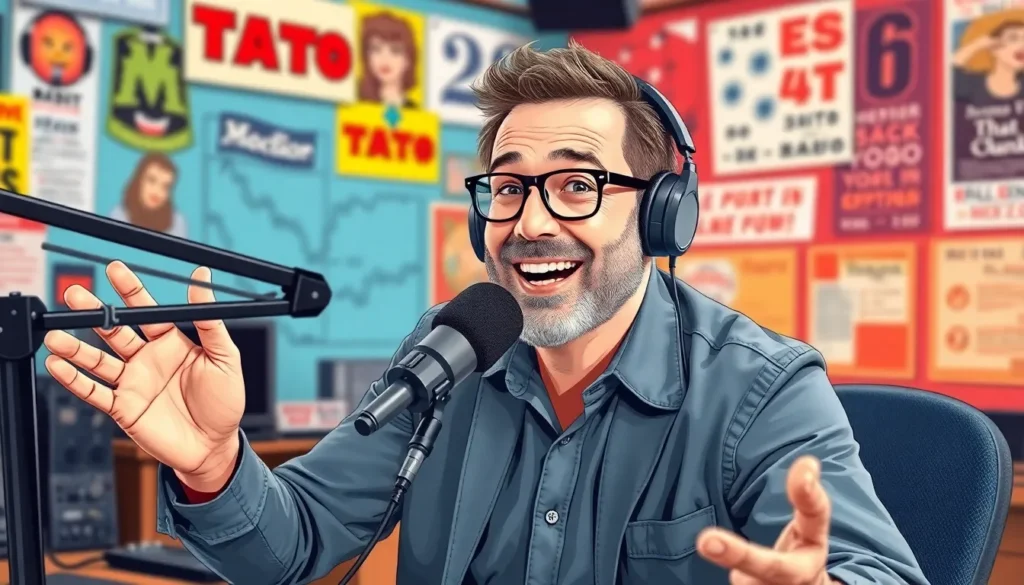Talk shows on TV have become a staple of modern entertainment, blending humor, celebrity gossip, and heartfelt moments into a delightful cocktail that keeps viewers coming back for more. From late-night legends to daytime divas, these shows offer a front-row seat to the lives of the rich and famous, all while delivering a healthy dose of laughs. Who wouldn’t want to watch a celebrity spill their secrets or engage in a hilarious skit?
But it’s not just about the glitz and glam. Talk shows often tackle real-world issues, making them both entertaining and enlightening. Whether it’s a light-hearted banter or a thought-provoking discussion, these shows have a unique way of connecting with audiences. So grab your popcorn, settle into your favorite couch, and get ready to dive into the captivating world of talk shows that keep us laughing and thinking long after the credits roll.
Talk Shows On TV
Talk shows on TV represent a unique blend of entertainment, information, and personality. They typically feature a host who engages with guests, creating an environment rich in discussion and interaction. Many of these programs focus on celebrity interviews, offering insights into famous figures’ lives, careers, and current projects.
Audience engagement plays a significant role in the success of talk shows. Viewers connect with the hosts and guests through relatable topics and shared experiences. This connection often leads to emotional segments that resonate deeply with audiences. Some shows even include audience participation, enhancing the interactive experience.
Genres within talk shows vary widely. Traditional formats often incorporate debates, where guests discuss pressing societal issues. Other formats blend comedy, skits, and live performances, adding entertainment value beyond standard interviews. Popular examples include late-night shows and daytime formats, catering to diverse viewer preferences.
Ratings and popularity differ among these programs. High television ratings indicate the impact and reach of talk shows, showcasing their significance in popular culture. Often, successful talk shows not only entertain but also inspire conversations around relevant social topics.
Innovation continuously shapes the landscape of talk shows. New approaches to content, such as incorporating social media interactions and live streaming, attract younger audiences. Adapting to viewer preferences ensures these shows maintain their relevance in an ever-evolving entertainment landscape.
The variety of topics covered also plays a crucial role. From politics to personal development, talk shows discuss a broad spectrum of subjects. This diversity attracts various demographic groups, contributing to sustained popularity and engagement.
Popular Talk Shows Today

Current talk shows attract a wide range of viewers. Their engaging formats blend entertainment with meaningful discussions.
Morning Talk Shows
Morning talk shows create a vibrant start to the day. Programs like “Good Morning America” and “Today” provide news updates alongside interviews with celebrities. Hosts foster a friendly atmosphere that encourages viewer interaction. Culinary segments and health tips capture audience interest. Around 3.3 million viewers tune into “Good Morning America” weekly, signaling its strong presence. These shows often cover lifestyle trends and community events, enhancing viewer connection.
Late Night Talk Shows
Late-night talk shows entertain audiences with humor and celebrity interviews. Shows such as “The Tonight Show Starring Jimmy Fallon” and “The Late Show with Stephen Colbert” stand out due to their unique comedic styles. Popular segments involve games and sketches, which draw audience engagement. The combination of topical humor and celebrity guests shapes their dynamic. For instance, “The Tonight Show” averages 1.7 million viewers each episode, illustrating its significant impact. Late-night formats promote cultural discussion, combining entertainment with current events, appealing to a broad demographic.
The Evolution of Talk Shows
Talk shows have transformed significantly over the decades, reflecting changes in society and viewer preferences. Various eras contributed to shaping the format we know today.
Historical Background
Talk shows originated in the 1940s, primarily as radio programs before transitioning to television. Early television talk shows featured hosts interviewing guests, often focusing on lighthearted topics. Notable examples include “The Ed Sullivan Show,” which premiered in 1948. This show blended interviews with musical performances, attracting a large audience. In the 1960s, hosts like Johnny Carson on “The Tonight Show” began to define the late-night format, establishing the rhythm of celebrity interviews mixed with comedic monologues. As audiences craved more relatable content, shows like “The Oprah Winfrey Show” emerged in the 1980s, introducing deeper emotional discussions and personal stories.
Changes in Format and Style
Formats adapted over time to maintain viewer interest. Early talk shows focused primarily on interviews with celebrities and public figures. Variation appeared with the introduction of panel discussions in the 1990s, showcasing multiple perspectives on trending topics. Current talk shows often integrate social media elements, allowing audiences to interact in real-time. This shift has given rise to innovative segments that include games, live audience participation, and viral challenges. Streaming platforms now host talk shows too, providing different distribution methods and extending their reach. Diversity in themes also increased, covering politics, mental health, and social issues, thereby appealing to a broader demographic.
Impact of Talk Shows on Society
Talk shows significantly influence societal norms and discussions. They shape cultural narratives while providing a platform for various issues.
Cultural Influence
Cultural influence of talk shows manifests through their ability to reflect and challenge societal values. Hosts often address trending topics, giving visibility to diverse perspectives. Viewers engage with relatable content that fosters discussions at home and within communities. Iconic moments on shows, such as surprise celebrity appearances or heartfelt interviews, create shared cultural experiences. For instance, Oprah’s impactful dialogues transformed conversation around personal issues, emphasizing empathy and understanding. These shows not only entertain but also inspire audiences to reflect on their own lives, thus playing a vital role in shaping societal attitudes.
Political Engagement
Political engagement in talk shows enhances viewer awareness of current events and civic issues. Through interviews and discussions, hosts invite guests from various political backgrounds, encouraging open dialogue. Shows like “The Late Show with Stephen Colbert” feature segments that simplify complex political topics, making them accessible to a wider audience. Consequently, audiences are more informed and encouraged to participate in civic activities. Social media interactions during broadcasts amplify the political discourse, allowing for real-time feedback and discussions. Engaging with these programs can motivate viewers to stay informed about election processes and community initiatives, highlighting their importance in the democratic process.
Future Trends in Talk Shows
Emerging trends in talk shows reflect changing viewer preferences and technological advancements. Streaming platforms increasingly host exclusive talk show content, allowing for greater flexibility in format and scheduling. Viewers now prefer on-demand access, leading to shorter segments and bite-sized updates that cater to busy lifestyles.
Social media integration continues to play a vital role. Hosts encourage real-time audience participation through polls, comments, and live Q&A sessions, creating a more interactive experience. This shift enhances viewer engagement and fosters a sense of community around the shows.
Diverse representation in guest selection remains essential. Programs now prioritize featuring voices from various backgrounds and experiences, addressing topics relevant to different demographics. Inclusion encourages broader discussions and attracts a wider audience.
In the realm of content, there’s a significant move towards more meaningful conversations. Hosts increasingly explore mental health, social justice, and climate change, engaging viewers on pressing issues. These topics resonate deeply, encouraging audiences to reflect and take action.
Technology also drives innovation in production. High-quality visuals, augmented reality, and immersive experiences elevate the viewing experience. Together, these advancements create dynamic presentation styles that captivate audiences.
As talk shows evolve, they adapt to cultural shifts and audience behaviors. These programs stand as pivotal platforms for discussion, entertainment, and connection, shaping the future of television. Insights into current issues and trends reinforce their status in popular culture, promising to maintain relevance in years to come.
Conclusion
Talk shows continue to captivate audiences by blending entertainment with meaningful discussions. Their ability to adapt to cultural shifts and viewer preferences ensures they remain relevant in today’s media landscape. As these platforms evolve they not only entertain but also foster important conversations around societal issues.
The diverse formats and engaging hosts create a unique viewing experience that resonates with a wide range of demographics. With the integration of technology and social media, talk shows are set to further enhance audience interaction and connection. This dynamic nature keeps them at the forefront of popular culture, making them an essential part of the television experience.



